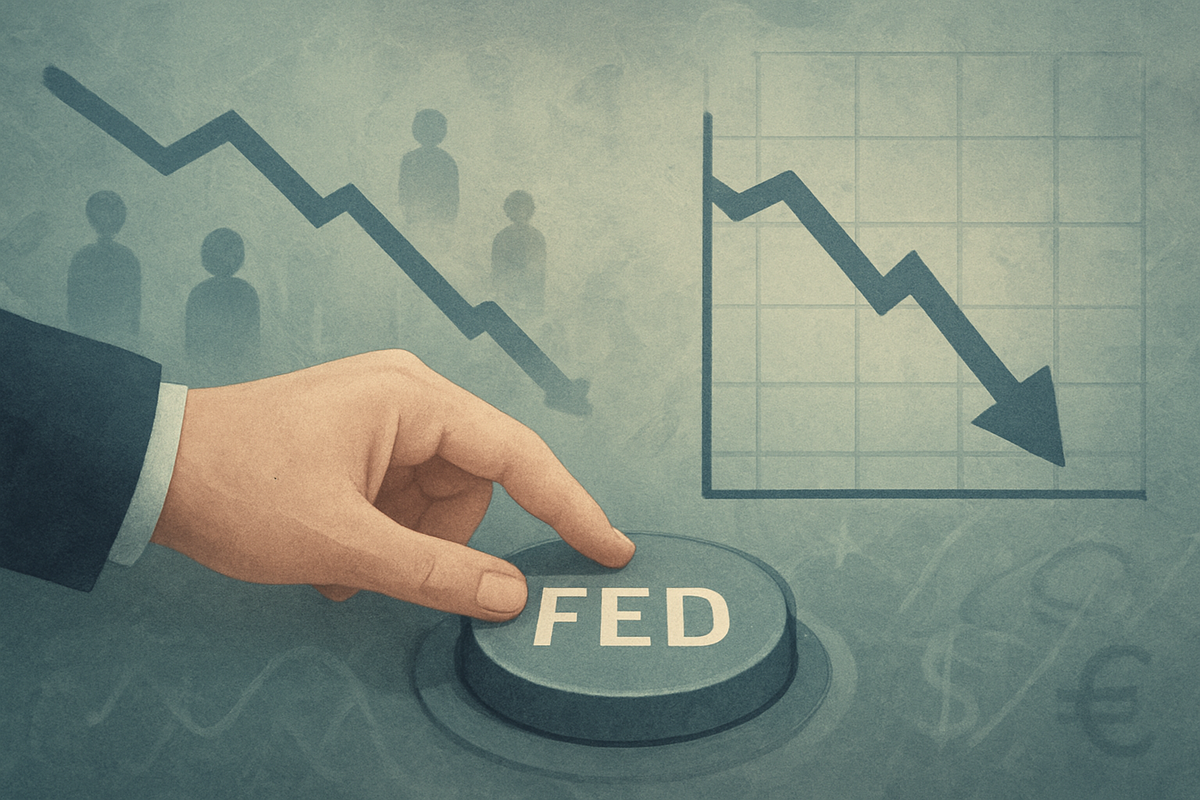
The U.S. job market is exhibiting undeniable signs of a significant slowdown, a trend that is profoundly influencing the Federal Reserve's monetary policy trajectory. Recent data, as of October 28, 2025, points to a substantial cooling, with job growth figures being revised downwards and unemployment ticking upwards. This shift is prompting the central bank to adopt an increasingly dovish stance, with market participants widely anticipating further interest rate cuts to stimulate economic activity and avert a deeper downturn.
This deceleration in employment, coupled with persistent inflationary pressures and the added complication of a government shutdown delaying crucial economic data, creates a complex landscape for policymakers. The Fed's pivot towards easing monetary policy reflects a strategic shift from its aggressive inflation-fighting posture to one prioritizing employment stability, signaling a critical juncture for the nation's economic future and financial markets.
A Deep Dive into the Decelerating Labor Market and the Fed's Dovish Pivot
The narrative of a robust post-pandemic labor market is rapidly giving way to one of caution and contraction. A preliminary benchmark revision from the Bureau of Labor Statistics (BLS) revealed a staggering overestimation of job growth from March 2024 to March 2025, indicating that nearly a million fewer jobs were created than initially reported. This unprecedented downward adjustment, the largest on record, fundamentally reshapes our understanding of the labor market's true strength over the past year. Further underscoring this trend, August 2025 nonfarm payrolls saw a modest rise of only 22,000 jobs, falling significantly short of both July's revised figures and market forecasts. Private-sector data from ADP corroborated this weakening, reporting a loss of 32,000 private-sector jobs in September, followed by a slight rebound in early October with an average addition of just 14,250 jobs per week.
The unemployment rate, a critical barometer of labor market health, rose to 4.3% in August 2025, marking its highest level since October 2021. More concerning is the surge in long-term unemployment, with 1.9 million individuals jobless for 27 weeks or more, representing 25.7% of all unemployed people – a level historically associated with economic recessions. Wage growth is also moderating, with average hourly earnings increasing by 3.7% over the past 12 months, a step down from the peak pressures of 2022-2023. A recent Bankrate survey highlighted that over two in five workers (43%) did not receive a pay increase in the last year, the highest rate in four years, signaling reduced household purchasing power.
This weakening employment picture is the primary catalyst behind the Federal Reserve's (NASDAQ: FED) noticeable shift towards a more dovish monetary policy. Faced with a cooling job market and despite lingering inflation (U.S. CPI rose to 2.9% annually in September 2025), the Fed is now prioritizing employment stability. Financial markets are overwhelmingly pricing in a 25-basis-point interest rate cut at the upcoming October 28-29 meeting, which would be the second consecutive reduction following a similar move in September. Analysts anticipate further easing into 2026, with some projections suggesting a total of 125 basis points in cuts. The central bank may also signal an end to its quantitative tightening program, marking a broader move towards accommodation. The ongoing U.S. government shutdown, which commenced on October 1, 2025, has introduced an additional layer of complexity, delaying the release of vital official data and forcing the Fed to rely more heavily on alternative sources and market signals for its critical policy decisions.
Initial market reactions reflect this complex environment. While the prospect of lower interest rates typically provides a boost to equity markets, the underlying concerns about economic deceleration and delayed data have fostered caution. Bond yields, particularly the one-year Treasury, have already compressed significantly, dropping approximately 150 basis points since June 2025, as investors factor in anticipated rate cuts. The U.S. Dollar (NYSE: USD) is facing downward pressure due to the government shutdown and the dovish Fed outlook, while safe-haven assets like gold (NYSE: GLD) have seen increased demand amidst heightened uncertainty.
Corporate Fortunes: Winners and Losers in a Cooling Market
The Federal Reserve's dovish pivot, driven by a cooling job market, creates a distinct landscape of winners and losers across various industries. Companies that are highly sensitive to interest rates and consumer spending will feel the most immediate effects.
Potential Winners:
- Housing and Real Estate: Lower interest rates directly translate to reduced mortgage costs, potentially re-energizing the housing market. Companies like Lennar Corporation (NYSE: LEN), D.R. Horton (NYSE: DHI), and other homebuilders could see increased demand. Real estate investment trusts (REITs) like Simon Property Group (NYSE: SPG) and Prologis (NYSE: PLD) may also benefit from lower borrowing costs for expansion and higher property valuations.
- Automotive Industry: Reduced auto loan rates could stimulate consumer demand for new vehicles. Manufacturers such as General Motors (NYSE: GM), Ford Motor Company (NYSE: F), and electric vehicle leader Tesla (NASDAQ: TSLA) might experience an uptick in sales, though broader economic slowdowns could temper enthusiasm.
- High-Growth Technology and Capital-Intensive Sectors: Companies that rely on debt financing for growth or have long investment cycles, particularly in technology, could see their cost of capital decrease. This includes innovative tech firms like NVIDIA Corporation (NASDAQ: NVDA) and Microsoft Corporation (NASDAQ: MSFT), as well as renewable energy companies that require substantial upfront investment.
- Consumer Discretionary (selectively): While overall consumer spending might moderate due to job market concerns, lower interest rates could free up some disposable income, benefiting certain consumer discretionary companies. However, this sector remains vulnerable if unemployment rises significantly. Retailers with strong balance sheets and adaptable strategies might fare better.
- Companies with High Debt Loads: Businesses carrying significant debt will see their interest expenses reduced, improving their profitability and financial stability. This could be particularly impactful for highly leveraged companies across various sectors.
Potential Losers:
- Financial Institutions (Banks): While lower rates can stimulate loan demand, they also compress net interest margins (NIMs), the difference between what banks earn on loans and pay on deposits. Major banks like JPMorgan Chase & Co. (NYSE: JPM), Bank of America (NYSE: BAC), and Wells Fargo & Company (NYSE: WFC) could see their profitability squeezed if the rate cuts are sustained and significant.
- Consumer Staples: While generally resilient in downturns, companies in this sector, such as Procter & Gamble (NYSE: PG) or Coca-Cola Company (NYSE: KO), might face pressure if consumers become more price-sensitive due to job insecurity, potentially shifting to private-label brands. Their steady, but often lower, growth rates might also make them less attractive compared to growth stocks benefiting from lower rates.
- Defensive Sectors (Utilities, Healthcare): These sectors, represented by companies like NextEra Energy (NYSE: NEE) or UnitedHealth Group (NYSE: UNH), are often favored during periods of economic uncertainty for their stable dividends and predictable earnings. However, in an environment of falling interest rates, their relative attractiveness might diminish as investors seek higher returns elsewhere, and their bond-like characteristics could see their valuations adjust.
- Companies reliant on a robust labor market: Staffing agencies, recruitment firms, and businesses heavily dependent on new hiring cycles will face headwinds. The "no hire, no fire" stance adopted by many companies, as highlighted by recent layoffs at Amazon.com Inc. (NASDAQ: AMZN) and Target Corporation (NYSE: TGT), directly impacts these service providers.
The ultimate impact on individual companies will depend on their specific business models, balance sheet strength, and ability to adapt to a changing economic environment characterized by lower borrowing costs but potentially softer demand.
Wider Significance: Navigating a New Economic Equilibrium
The cooling U.S. job market and the Federal Reserve's subsequent dovish stance represent a significant inflection point, fitting into broader industry trends and carrying profound implications beyond immediate market reactions. This shift signals a move towards a new economic equilibrium, one where the era of rapid post-pandemic recovery is yielding to a more moderated, and potentially challenging, growth environment.
This event directly impacts the ongoing debate about a "soft landing" versus a recession. The Fed's aggressive rate hikes over the past two years were intended to curb inflation without triggering a severe economic downturn. The current job market data suggests that the tightening has indeed taken hold, but the risk now lies in overshooting, pushing the economy into a recession. The rapid rise in long-term unemployment and the dip in consumer confidence, particularly concerns about future job prospects, amplify these recessionary fears. This scenario could lead to a feedback loop where businesses, anticipating weaker demand, further reduce hiring and investment, exacerbating the slowdown.
Potential ripple effects on competitors and partners are substantial. Globally, central banks often observe the Federal Reserve's actions closely. A sustained dovish stance from the Fed could embolden other central banks to consider their own rate cuts, potentially leading to a synchronized global easing cycle. This could offer some relief to multinational corporations and boost international trade, but it also signals a collective acknowledgment of weakening global economic conditions. For companies, particularly those in manufacturing and services, the ISM reports indicating contraction in both sectors suggest that the slowdown is broad-based, affecting supply chains and demand across industries.
Regulatory and policy implications are also significant. The ongoing government shutdown, which has delayed critical economic data releases, complicates the Fed's ability to make informed decisions. This "data vacuum" underscores the importance of reliable, timely economic indicators for effective policymaking and could prompt calls for reforms to prevent future data disruptions. Furthermore, if the economic slowdown deepens, pressure will mount on fiscal policymakers to consider stimulus measures, potentially reigniting debates about government spending and national debt. The Fed's dual mandate of maximum employment and price stability is under intense scrutiny, and its actions will be closely watched for their long-term impact on these objectives.
Historically, periods of significant labor market cooling have often preceded or coincided with economic downturns. The current rise in long-term unemployment above the 25% threshold, for instance, has been a reliable indicator in the past. Comparisons can be drawn to periods like the early 2000s or even the pre-Great Recession era, where initial signs of labor market weakness were followed by more severe economic contractions. However, the unique circumstances of persistent inflation alongside a cooling job market, termed "stagflationary concerns," differentiate this period from purely demand-driven slowdowns, making the Fed's navigation particularly challenging and its policy tools potentially less effective in addressing both issues simultaneously. The challenge is to ease enough to support employment without re-igniting inflation.
The Road Ahead: Scenarios and Strategic Adaptations
The path forward for the U.S. economy and financial markets is marked by several potential scenarios, each demanding strategic pivots and adaptations from businesses and investors. The immediate future will be heavily influenced by the Federal Reserve's actions, the trajectory of inflation, and the resolution of the government shutdown.
In the short-term, the most likely scenario involves the Federal Reserve proceeding with anticipated interest rate cuts. This easing of monetary policy aims to provide a much-needed stimulus to the economy, potentially lowering borrowing costs for consumers and businesses, and thus encouraging investment and spending. However, the effectiveness of these cuts could be hampered if consumer and business confidence remains low due to job insecurity and broader economic uncertainty. Companies will need to closely monitor their cash flow and debt levels, potentially accelerating debt reduction or refinancing at lower rates. Investors should prepare for continued market volatility, as conflicting signals from the labor market, inflation, and policy decisions create an unpredictable environment. Sectors sensitive to interest rates, like housing and technology, might see initial boosts, but sustained gains will depend on a genuine economic rebound.
Looking into the long-term, several possibilities emerge. One scenario is a successful "soft landing," where the Fed's rate cuts stabilize the job market and gently guide the economy back to sustainable growth without triggering a recession. This would require inflation to cool further and the labor market to find a new equilibrium. In this optimistic outlook, businesses might gradually increase hiring and investment, and consumer spending would recover. Another, more challenging scenario, is a deeper economic downturn or even a recession. If the job market continues to deteriorate, and rate cuts prove insufficient to counter the slowdown, businesses could face significant demand destruction, leading to further layoffs and corporate distress. In this case, companies would need to focus on cost optimization, efficiency gains, and protecting profit margins, while investors might shift towards more defensive assets.
Market opportunities and challenges will emerge from these evolving conditions. For businesses, the challenge lies in adapting to potentially softer demand while leveraging lower borrowing costs for strategic investments in areas like automation, AI, and supply chain resilience to enhance long-term competitiveness. Companies with strong balance sheets and innovative products may find opportunities to gain market share from weaker competitors. For investors, opportunities could arise in undervalued growth stocks that benefit from lower rates, or in companies that demonstrate resilience and strong fundamentals during economic turbulence. However, the risk of misjudging the Fed's trajectory or the depth of the economic slowdown remains a significant challenge.
Potential strategic pivots for corporations include re-evaluating expansion plans, focusing on core competencies, and optimizing operational efficiencies. For the public, adapting to a potentially tighter job market means prioritizing skill development and financial prudence. The resolution of the government shutdown is also critical, as the return of official data will provide clearer signals for all stakeholders, allowing for more precise economic forecasting and policy adjustments.
Wrap-Up: Navigating Uncertainty in a Shifting Economic Landscape
The U.S. economy is at a critical juncture, defined by a decisively cooling job market and a Federal Reserve poised for further monetary easing. The key takeaways from recent data are clear: job growth has decelerated significantly, unemployment is rising, and long-term joblessness is becoming a growing concern. This weakening labor market has been the primary catalyst for the Fed's dovish pivot, with market expectations firmly set on continued interest rate cuts to avert a deeper economic contraction. However, the persistence of inflation above target, coupled with the complicating factor of a government shutdown delaying crucial economic data, creates an environment of heightened uncertainty.
Moving forward, the market will be a delicate balance between the stimulating effects of lower interest rates and the dampening effects of a slowing economy. While lower borrowing costs are expected to provide some relief to consumers and businesses, particularly in interest-sensitive sectors like housing and automotive, the underlying concerns about job security and consumer confidence could temper their impact. Financial institutions, on the other hand, might face pressure on their net interest margins. The Fed's ability to orchestrate a "soft landing" – bringing inflation down without triggering a recession – remains the central challenge, and its success will largely dictate the trajectory of the economy in the coming months.
The lasting impact of this period could be a recalibration of economic expectations, where the rapid growth of the immediate post-pandemic era gives way to a more measured pace. Businesses that demonstrate agility in adapting to changing demand patterns and optimizing their cost structures will be best positioned to thrive. For investors, vigilance is paramount. They should watch closely for the Fed's official statements and any changes in its forward guidance, monitor inflation data (once available), and pay particular attention to consumer spending trends and corporate earnings reports for signs of resilience or distress. The interplay between these factors will determine whether the current cooling evolves into a manageable slowdown or a more significant economic challenge.
This content is intended for informational purposes only and is not financial advice






